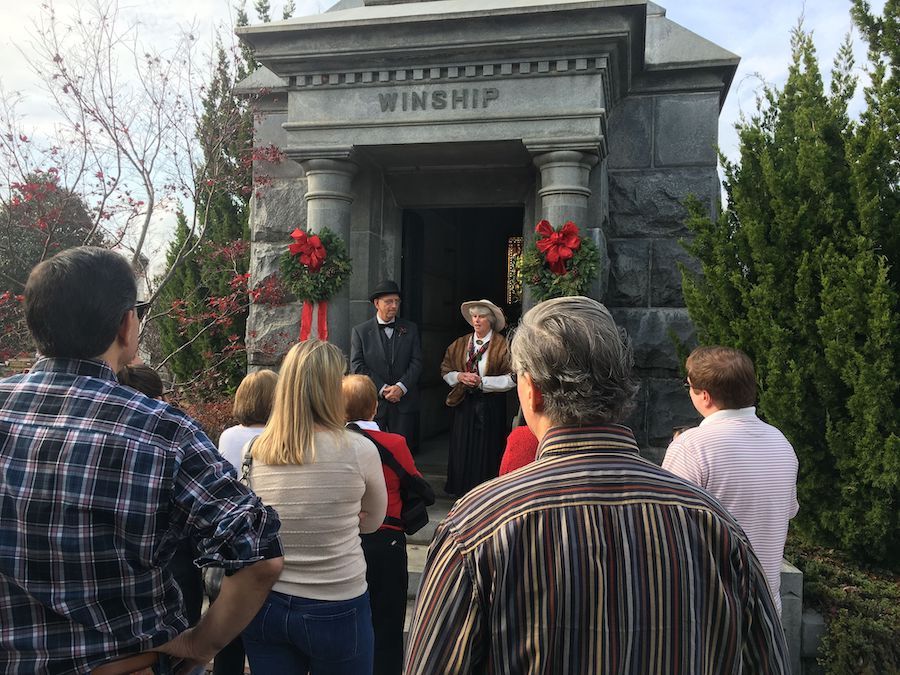
At the annual Victorian Holiday at Oakland Cemetery in Atlanta, Georgia visitors encounter costumed docents and shop for wreaths and Christmas trees in the Holiday Green Market. Photo courtesy of Historic Oakland Foundation
By Teresa Bergen
It’s dark, cold and drizzly while Emma Merlotin stands on her grave, bemoaning her long-ago murder in a French accent. Around her at Lone Fir Cemetery in Portland, Oregon, people listen to the costumed actress or drift over to check out the souped-up rides of a local hearse club. It’s Halloween night, when the pioneer cemetery hosts its Tour of Untimely Departures—originally started as an attempt to avoid vandalism, and now a favorite October party.
Around the world, cemeteries are recognizing the importance of inviting the public inside graveyard gates. From historic tours to running events and summer concerts, cemetery directors are expanding programming in an attempt to be relevant community institutions, not just creepy neighbors.
Garden cemetery movement
“Cemetery tourism is not new,” says David Charles Sloane. “It’s been around for as long as there have been cemeteries.” Sloane, a professor in the University of Southern California’s Department of Urban Planning and Spatial Analysis, grew up in Oakwood Cemetery in Syracuse, New York. His father, Jack Sloane, ran Oakwood, and several generations of his forefathers managed cemeteries in Ohio. Attracting visitors is crucial to cemeteries, he says. “For them to continue to service [the community] in multiple ways, they have to do more than just inter the dead.”
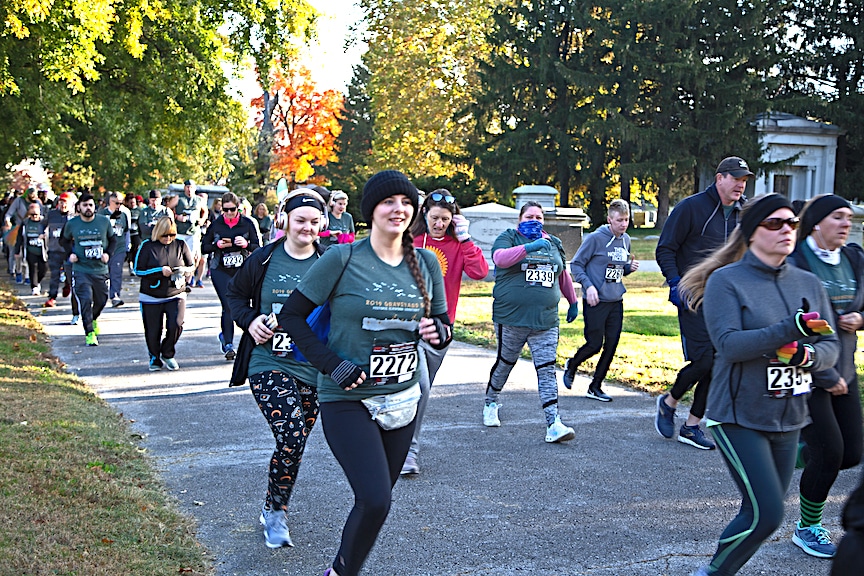
In Kansas City, Missouri the KC Crew’s annual Graveyard 5K helps historic Elmwood Cemetery raise funds for maintenance. Photo courtesy of KC Crew, an adult recreational sports league
The US movement to make cemeteries welcoming green spaces started in 1831, when the Massachusetts Horticultural Society bought 72 acres of woodland in Cambridge and developed Mount Auburn Cemetery. This was the first of many garden cemeteries with picnic grounds and wooded paths for strolling. Also called rural cemeteries, this model quickly spread around the US and Europe, with more than 100 built in the United States.
Forest Home Cemetery in Milwaukee opened for business in 1850. “It was the first landscaped public place that people could go,” says Sara Tomlin, assistant executive director of the cemetery. City surveyor Increase Lapham modeled Forest Home after Mount Auburn. “So we have records of like 8,000 people coming on a single day to picnic and be with their families,” says Tomlin. “It was their getaway before public parks existed.” Back then, Forest Home was outside of Milwaukee. Horse-drawn carriages dropped people off in the cemetery’s Victorian garden, and they would spend the whole day.
Historical Tours
When Glen Treibs leads visitors through Der Stadt Friedhof Cemetery in Fredericksburg, Texas, it’s an intensely personal tour. This isn’t a beautiful cemetery. Instead, it’s orderly in that precise German way, with clearly delineated plots of land lined by concrete curbing. Children are buried together in a separate spot since the shorter bodies line up better. Treibs, a historian and strictly volunteer tour guide—“When someone hands me a check I feel like a Bavarian peasant”— knows the story of everybody buried here. No wonder. He lives on land his German immigrant forebears bought in 1849. As he leads visitors between neatly laid out rectangles, he comments on the hardships Germans faced in the New World. “This was the first home of many of our colonists. Even before they got a log cabin built, they were dead.”
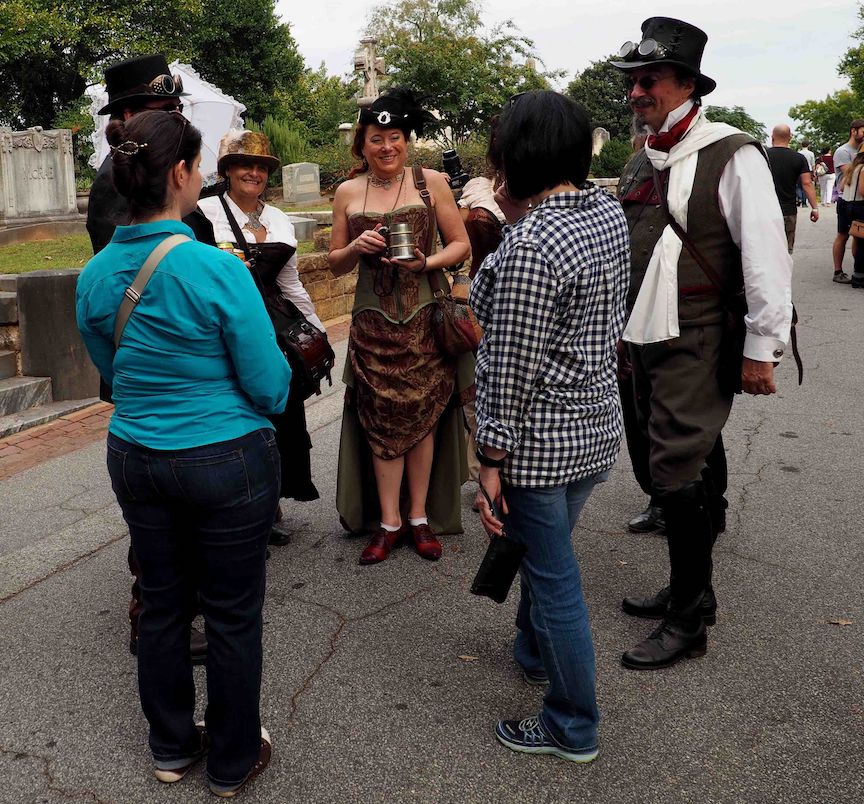
Sunday in the Park, Oakland Cemetery’s annual fall festival, returned for its 43rd year in 2021. Attendees enjoy vendors, an artist market, craft beers, food trucks and a Tunes from the Tomb concert. Photo courtesy of Historic Oakland Foundation
Contrast that to tours given in Père Lachaise, the world’s most visited cemetery, which attracts more than three million people from around the world each year. In 1799, Napoleon Bonaparte challenged Paris’ city planners to solve the problem of too many dead bodies in an overcrowded city. Architect Alexandre-Théodore Brongniart won the competition for best design and today more than one million people are buried in the huge garden cemetery. Instead of the local focus of a small cemetery like Der Stadt Friedhof, Père LaChaise boasts paved roads lined with expensive private mausoleums and impressive statuary. Visitors hire guides to direct them to the celebrity graves of Jim Morrison, Frederic Chopin, Oscar Wilde, Edith Piaf and Gertrude Stein, among others.
Historical tours are the bread and butter of organized cemetery tourism. Larger cemeteries may offer multiple tours with different focuses. At Forest Home in Milwaukee, visitors can choose between seeing the graves of beer barons, Civil War veterans, architects, suffragists or abolitionists. Buenos Aires’ famous Recoleta Cemetery—permanent home of Eva Perón–has a tour that takes three hours. While most historical tours in cemeteries are on foot, 478-acre Green-Wood in Brooklyn also runs a trolley tour.
Halloween & Dia de los Muertos
Some cemeteries get more creative in their programming than others. In Atlanta, Georgia, Oakland Cemetery, founded in 1850, is especially forward-thinking about new ways to engage the community. October is a big month. Children can plan their jack-o-lanterns while shopping the annual pumpkin patch, and families can pose for portraits in front of the Richards Mausoleum—a Halloween natural with its gothic revival bat-winged gargoyles. Participants in the annual Run Like Hell 5K, billed as the country’s largest cemetery run, are urged to compete in costume. In springtime, visitors might find art installations among the graves. This year’s Tunes from the Tombs concert series brought reggae band The Original Wailers to Oakland, along with craft beer and an artist market.
At Hollywood Forever in California, thousands of people come to watch classic films screened on an exterior mausoleum wall. The cemetery offers concerts, lectures, literary events, podcast tapings and one of the largest Día de los Muertos festivals in the country. This year’s Dia de los Muertos celebration is divided into two separate events. By day, family-friendly offerings include a children’s plaza and folkloric music and dance. At night, the music will get louder and more rocking. Expect taco vendors at both.
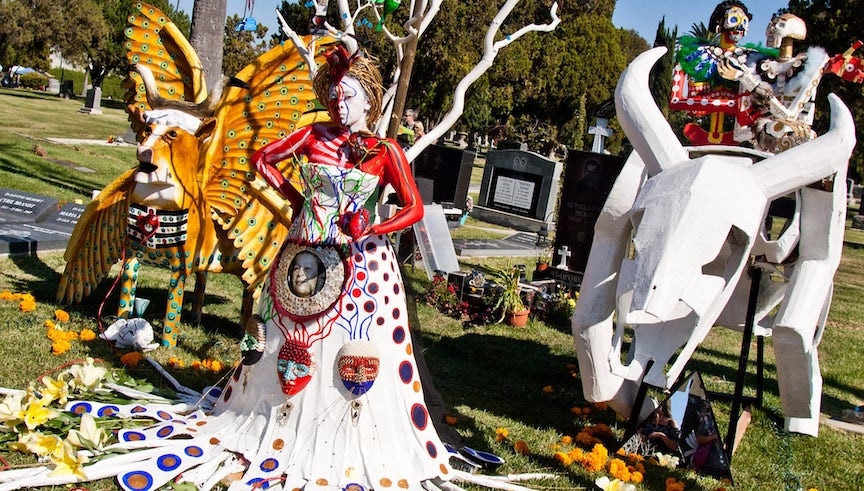
Hollywood Forever goes all out for its annual Dia de Los Muertos event. This year’s theme is “The Return of Quetzalcoatl.” Photo courtesy of Hollywood Forever
Forest Home is also celebrating Día de los Muertos this year. “Part of the Day of the Dead event is to try to connect with the Latino community,” says Tomlin. About 65% of the surrounding neighborhood is Latino. Seven Latinas from the community are on the committee that’s putting on the event. The cemetery hired local artists to create three different ofrendras, or altars to the dead. Activities include a 5K with a mariachi band at the finish line, traditional dancing, food trucks, and kids’ arts and crafts.
Cemetery museums
Dublin’s Glasnevin Cemetery may be the final resting place most equipped for tourists. About 1.5 million people make their eternal homes in Ireland’s largest cemetery, including the 20th century revolutionary Michael Collins and most of the folks killed in the 1916 Easter Rising. Ireland’s largest round tower contains most of 19th century political leader Daniel O’Connell– the heart of the founder of the Catholic Association is in Rome. Visitors who climb O’Connell Tower’s 222 steps can gaze out over the Irish Sea.
In 2010, Glasnevin opoened its own museum. The main floor of the museum is currently showing an exhibit called “Extra-ordinary Lives,” focusing on some of the cemetery’s lesser-known residents as well as significant historical figures in sports and arts. Downstairs, the City of the Dead exhibition teaches visitors about funeral traditions around the world. There’s a museum shop where visitors can buy historical books and Irish crafts, a genealogy research area and even the Tower Café—a rare chance to order a scone or artisan sandwich amidst stunning tombstones–all set within high walls originally built to deter grave robbers.
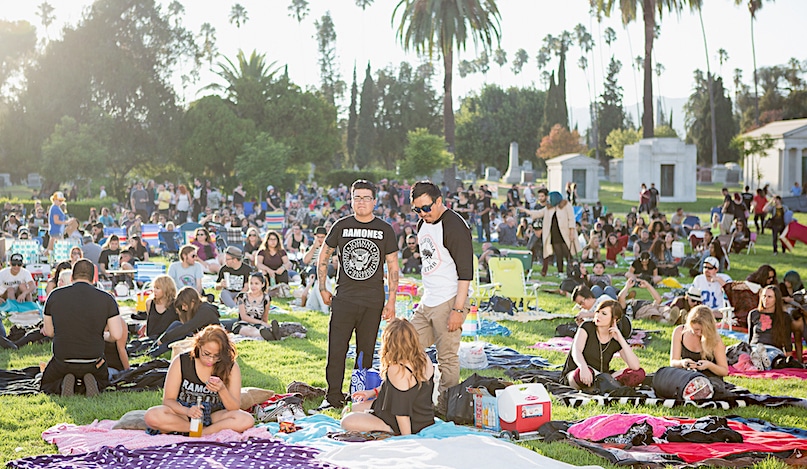
People gather in Hollywood Forever for a tenth anniversary tribute to Johnny Ramone. The legendary punk rocker was laid to rest here in 2004. Photo courtesy of Hollywood Forever
Graveyards and green space
While American cities now have more parks than they did in the 1800s, cemeteries still fill a need for green space. The lure of trees, plants, birds and fresh air is attractive to many—even those who aren’t excited about all those graves.
Ed Bixby, a real estate developer turned cemeterian, has acquired and revamped four pioneer cemeteries—one in New Jersey, two in California and one in Oregon. “The way I designed my cemeteries and the way I operate them is to try to make them green spaces for the living,” he says. “We want to make them really a desirable place to visit, not only for the history but for the recreational aspects as well. Make it a place that the community can embrace and enjoy visiting, even if don’t have loved ones there.” When Bixby took over Historic Columbian Cemetery in an industrial part of Portland, Oregon, he invited 40 vendors to participate in a fall festival on cemetery grounds. Now that they know they’re welcome, more people walk their dogs in the cemetery.
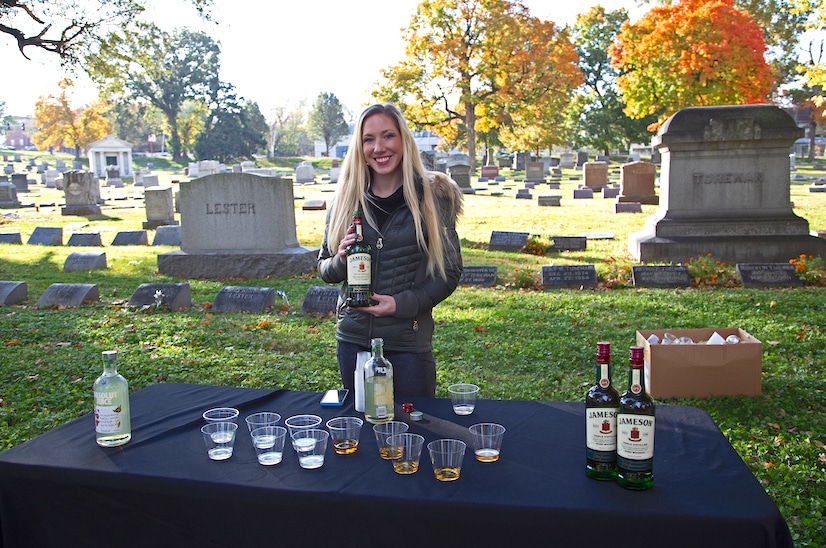
It’s okay to drink in cemeteries—at least during official tastings. Here, whiskey awaits finishers of the Graveyard 5K at Elmwood Cemetery in Kansas City. Photo courtesy of KC Crew
Some cemeteries also double as arboretums. Forest Home is a certified Level II arboretum, which means it has more than 100 species of trees, a collection policy, paid staff and educational programs like tree walks. Birding is also a popular activity in larger cemeteries.
Mourners and tourists
During the pandemic, many cemeteries experienced an influx of people as local parks overflowed. At Portland’s Lone Fir, suddenly toddlers were careening down cemetery paths as they learned to ride tiny bicycles, and bikini-clad twenty-somethings were lounging on blankets puffing on (legal in Oregon) joints. For people visiting family graves, this could be a tad unsettling.
So how should cemeteries balance the comfort of mourners with the need for capturing the interest of the non-mourning public? “Delicately,” says Sloane. “Your job is to service the survivors who have brought their loved one to your cemetery. Whether it be an interment, burial, cremation, scattering, whatever it is, they have given you something of great meaning to them. So you have to be careful about not offending them.”
The definition of offensive is generational, says Sloane. Many things that happen today in cemeteries would not have been acceptable in his father’s time. “My dad was always a little freaked out about joggers. Because they often weren’t dressed like they were in mourning gear,” he says. Nor did his father want to promote ghosts or, worse, notorious criminals. “There was a serial killer in Syracuse when I was a teenager, actually in the Adirondacks. And he was buried in Oakwood. You couldn’t get the information on where he was anywhere because my dad didn’t want it to become someplace that people would go.”
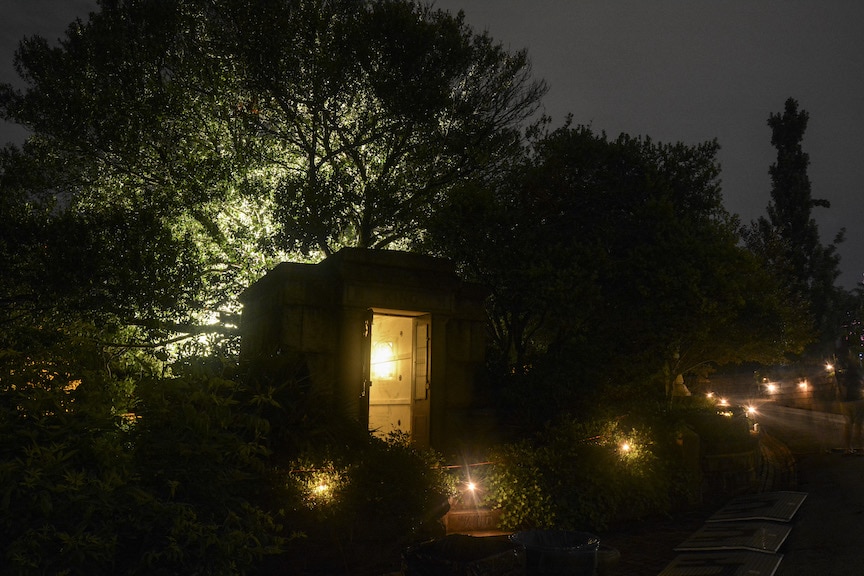
“Illumine,” a special night-time experience, uses light, sound and shadows to highlight stories of different residents each year, including some of the lesser-known. Photo courtesy of Historic Oakland Foundation
At the same time, a cemetery is a community institution that needs to look beyond its very narrow role as a place of mourning. “You want community members to come through that cemetery because then they might bring their loved one who passed away there,” says Sloane. “I mean, it’s part of branding, marketing.”
Cemetery Yoga
In Milwaukee, Forest Home is planning a rebrand. Tomlin has a background in arts nonprofits and took the cemetery position just before the pandemic. She’s planning to revamp the website, printed materials, and especially the signage to make it look more welcoming to the neighborhood. When considering programming, Tomlin keeps the cemetery’s main focuses in mind: history, remembering those who have died and highlighting green space in a now heavily immigrant neighborhood with few parks. Forest Home allows bicycles, leashed dogs, and walking groups. The cemetery has welcomed everybody from the Milwaukee Police wellness group to members of the Milwaukee Paranormal Conference coming for the cemetery’s monthly yoga class. Tomlin hopes that the more people use and appreciate the cemetery, the fewer problems they’ll have with vandals or other destructive types.
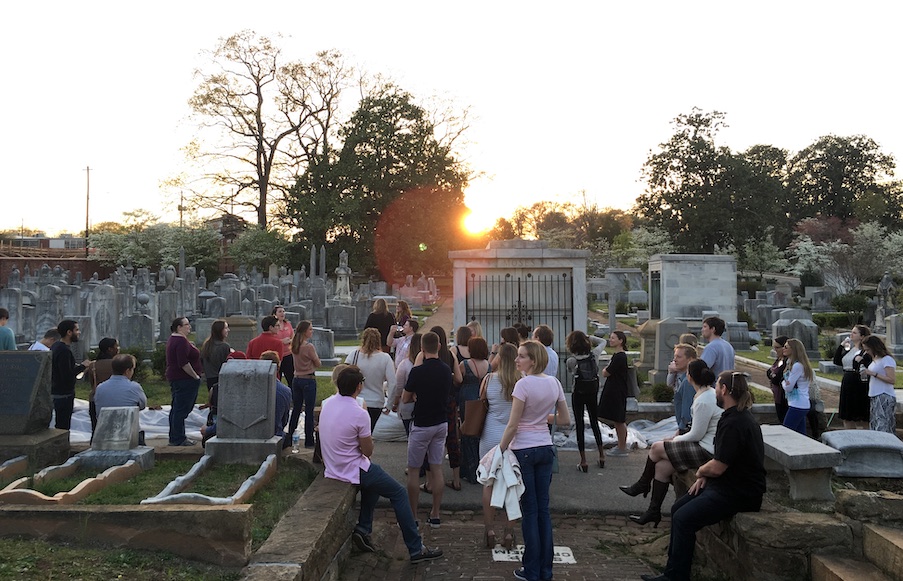
Cemetery sundown tours became popular during the pandemic and continue to attract neighbors who are curious about interesting characters interred nearby.
Around the world, cemeteries are revving up their public programming, trying to gain enough interest to fund preservation efforts. The Association of Significant Cemeteries in Europe has scores of members who work together to raise interest in what they consider their open-air museums from Oslo to Estonia. As its website poetically puts it, “All in vain is the amazingly preserved cultural heritage of the cemetery, if its sparkling stories of love, wars and discoveries are not joyfully talked about, touched and remembered.” ![]()
Teresa Bergen is a Portland, Oregon-based travel writer, who is often found poking around in an old cemetery. She is the author of Easy Portland Outdoors and co-author of Historic Cemeteries of Portland, Oregon. Teresa is a member of the Society of American Travel Writers and has a BA in journalism and an MFA in fiction writing.

